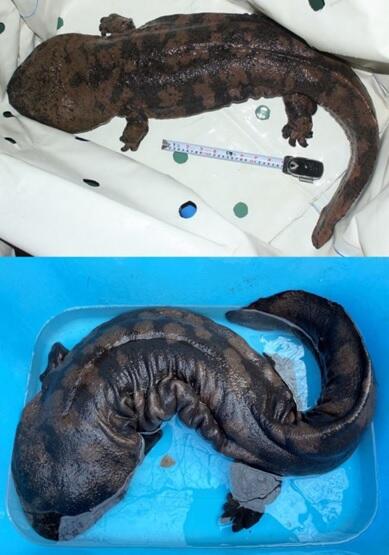Two individuals of a giant salamander species considered to be extinct in China were recently found in Japan: one at a zoo and the other at an aquarium. This discovery was made by the research group comprised of Professor Kanto Nishikawa and Professor Emeritus Masafumi Matsui of the Graduate School of Global Environmental Studies, Kyoto University, in joint collaboration with the National Museum of Nature and Science, the University of the Ryukyus, and the Kitakyushu Museum of Natural History and Human History. This is an excellent example of how alien species, treated as a nuisance in the countries or regions where they are introduced, can contribute to the conservation of global species diversity. The discovery was published in Scientific Reports.

Provided by Asa Zoo
The Chinese giant salamander was introduced into Japan after the 1960s, following which they escaped from the breeding facilities or were released into open rivers. Subsequently, they crossed with the Japanese giant salamander (Special Natural Monument Species in Japan), causing problems in various places. However, even the genetically pure Chinese giant salamanders first released into Japanese rivers are facing possible extinction in their original habitats in China. Recent research has shown that the Chinese giant salamander has been divided into several species and that it is highly likely that some of them are already extinct or on the verge of extinction.
For the screening of hybrid giant salamanders, the research group collected samples of Japanese giant salamander caught in the Kamogawa River in Kyoto City and in rivers in Mie, Nara, and Tokushima prefectures as well as samples of Chinese giant salamander bred in the zoo, aquarium, and home. The genotypes of the collected samples of Japanese and Chinese giant salamander were compared to survey the microsatellite regions of their mitochondrial and nuclear DNAs. As a result, 45 hybrid individuals and 28 Chinese giant salamander individuals were found. Among the latter, four individuals of the species Andrias sligoi, which was thought to be extinct in China, were discovered. Unfortunately, of the four individuals, only two kept at Sunshine Aquarium (Ikebukuro-City, Tokyo) and Hiroshima City Asa Zoological Park, respectively, are still alive.
Visual determination of the gender of giant salamanders is difficult (except during the breeding season). The research group used a polymerase chain reaction (PCR) method with specific primers to determine if a partial region of the female sex chromosome could be amplified from the DNAs of the two living samples. No amplification was observed, indicating that the two individuals were male.
A. sligoi was previously thought to be a new species. Researchers later classified it to the same kind of Chinese giant salamander although the name is different. In 2019, it once again became an independent species. At the time of the original report, only one dead sample was investigated. When A. sligoi was classified as an independent species, the field population was extinct. The body color and morphology of living individuals were first observed this time. As a result of the present research, it also became clear that there may have been a mistake in the original investigation report, and the classification research has progressed.
A. sligoi is the largest species of the giant salamander family and the world's largest amphibian. Although the species is extinct in the original habitat area, population recovery is expected. The research group commissioned Researcher Manabu Onuma of the National Institute for Environmental Studies to cryopreserve germ cells from the living males and revive clone individuals using tissues from the dead females and the aforementioned cells. They are planning to artificially breed the species using the revived individuals.
The Chinese giant salamander itself is also a valuable species. Plans are under way to move the individuals found and bred in the zoo and aquarium in Japan to the zoo in the UK, where they will be collectively kept to artificially breed each strain, and to release them into nature in the future.
Journal Information
Publication: Scientific Reports
Title: Discovery of ex situ individuals of Andrias sligoi, an extremely endangered species and one of the largest amphibians worldwide
DOI: 10.1038/s41598-024-52907-6
This article has been translated by JST with permission from The Science News Ltd. (https://sci-news.co.jp/). Unauthorized reproduction of the article and photographs is prohibited.




